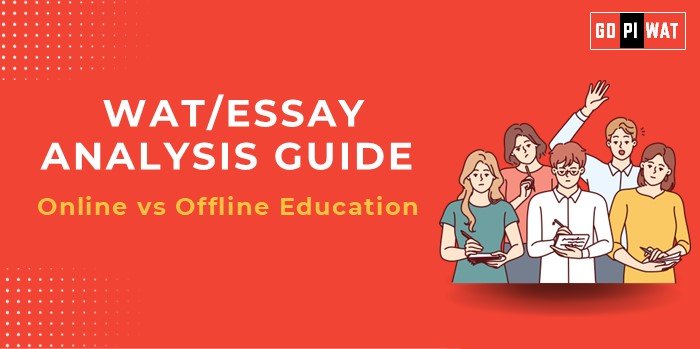📋 Online vs Offline Education – Which is Better?
🌐 Understanding the Importance of Online vs Offline Education
The comparison of online and offline education is vital for B-schools, as they consider digital innovation’s impact on future learning models.
This topic highlights educational flexibility, inclusivity, and effectiveness, which are key concerns in today’s globalized world.
📝 Effective Planning and Writing
- Time Allocation:
- ⏳ Planning: 5 minutes
- ✍️ Writing: 20 minutes
- 🔍 Review: 5 minutes
- Preparation Tips: Identify key statistics, compare strengths and weaknesses, and incorporate examples from hybrid learning models worldwide.
💡 Introduction Techniques for Essays
- 🔄 Contrast Introduction: “Online education offers flexibility, yet traditional classrooms provide structure and direct interaction, making both essential in today’s learning landscape.”
- 🤝 Solution-Oriented Introduction: “A hybrid approach combining online accessibility with offline engagement may be the optimal path for modern education.”
- 📜 Historical Context: “From traditional classrooms to virtual setups post-pandemic, education has evolved, highlighting the pros and cons of both models.”
🏗️ Structuring the Essay Body
- 🌍 Achievements of Online Education: Accessible, flexible, and environmentally friendly, catering to students in remote areas.
- ⚠️ Challenges of Online Education: Digital divide, engagement challenges, and lack of in-person interaction.
- 🧑🤝🧑 Offline Education Strengths: Supports social development, offers structured environments, and enhances engagement and immediate feedback.
- 🚧 Challenges of Offline Education: Limited flexibility, higher infrastructure costs, and geographic constraints.
📈 Concluding Effectively
- ⚖️ Balanced Conclusion: “Both online and offline education offer distinct advantages, with a hybrid approach likely providing the most effective learning experience.”
- 🌏 Global Comparison Conclusion: “Countries embracing hybrid models show that combining online and offline education can address accessibility and engagement challenges effectively.”
🔍 Analyzing Successes and Shortcomings
- 🏆 Key Achievements: Online education democratizes learning access, while offline education enhances social skills and focus.
- ⚠️ Ongoing Challenges: Infrastructure limitations for online learning and cost barriers in offline education.
- 🌎 Global Context: Finland’s hybrid approach and the US’s expanded online programs demonstrate the global trend towards integrating both models.
🌟 Recommendations for Sustainable Progress
- 🔄 Blend Learning Models: Embrace hybrid curriculums to leverage both formats’ strengths.
- 🌐 Invest in Digital Infrastructure: Improve internet access and tech resources in underserved regions to bridge the digital divide.
- 📚 Promote Digital Literacy: Equip students with skills to benefit fully from online learning, especially in low-access areas.
📄 Sample Short Essays on Online vs Offline Education
- ⚖️ Balanced Perspective: “Both online and offline education provide unique advantages. While online platforms increase accessibility, in-person learning enhances engagement. A hybrid model could meet the demands of modern learners.”
- 🤝 Solution-Oriented: “The debate between online and offline education need not be exclusive. Integrating both approaches could offer a comprehensive and adaptable education system for diverse learning needs.”
- 🌍 Global Comparison: “Countries using hybrid models show that combining online and offline education can create accessible, engaging, and effective learning experiences.”


